A comparison of the best: the Sennheiser and the Bose
By Lucy Komisar
Ready for a nice, relaxing airplane ride? You climb into your hard plush seat, fasten the safety belt, pull out a magazine or book and then, as you start the ascent into several hours locked in place, there comes a steady, all-encompassing roaaarrrr! And it won‘t go away. Not while the engines are turning, since that‘s the price of air travel. Or is it?
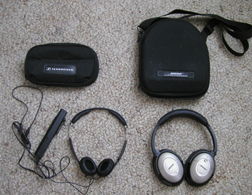
The inventors of headphones for the people who obsess about the sound quality of their music have figured out that those headsets can serve another function: to achieve blessed quiet. Or relative quiet compared to what airplane noise sounds like without them.
Wearing “noise-canceling headsets” is not the same as sticking earplugs in your ears. Engineers have figured out how to create a “counter-noise” that drowns out a steady low frequency hum.
When you push the switch on the battery-operated mechanism, a sound you can‘t hear attacks the noise you don‘t want to hear. That also makes music aloft sound better. I looked at two, the Sennheiser and the Bose.
As the Sennheiser company explains: “The NoiseGard™ technology developed by Sennheiser is based on the principle that unwanted low-frequency noise can be eliminated by adding phase-inverted anti-noise.
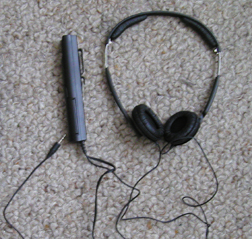
For this, small microphones (usually in the ear cups) pick up the ambient noise. The NoiseGard™ electronics then generate an identical signal – but phase-inverted by 180 °. Thus the two noise signal waves cancel each other out to a very large extent.”
Bose‘s principle is similar: “Microphones in the ear cups actively monitor the sounds you hear. The difference between the unwanted sound and the desired sound is then electronically processed. The driver within the ear cup creates a correction signal that opposes the effect of the outside noise and that, combined with the passive attenuation of the headset itself, dramatically reduces it.”
The system really works. It won‘t eliminate voices or sporadic or high frequency noise. You can hear the cabin attendants and loudspeaker announcements. Though the headsets cut the sound of neighbors‘ conversations, they won‘t drown out a screaming kid. But they really stifle engine noise.
There are three kinds of headphones. One fits over the ear opening, one covers the entire ear, and one fits inside the ear canal. I tried the first two. I find ear plugs annoying and irritating after long use, so I didn‘t want the ear canal kind.
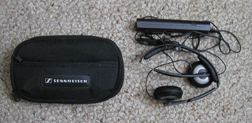
As I experimented with the two top-rated systems, I thought I can‘t ever fly again without one. I chose the Sennheiser PXC 250 and the Bose QuietComfort 2 after doing a lot of internet research; they were the only ones that routinely came up at the top of reviewers‘ and consumers‘ lists.
The Sennheiser fits over the ear opening. I used it on a trip to London where I sat right behind the wing. It cut the sound of the engines substantially. I kept moving the phones off and on my ears to note the difference. Without them, I got the roar of the engines; with them, I heard a sound that reminded me of a seashell pressed to the ear. It was definitely more pleasing.
The reduced noise wasn‘t just from the earphones acting as a physical barrier. I moved the power button on and off to see if there was a difference. On “off,” the seashell sound turned back to an engine!
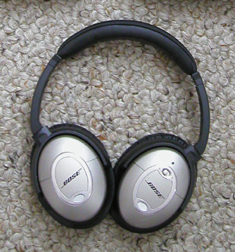
The soft foam cushion Sennheiser earphones are extremely comfortable. The 2 AAA batteries are in a plastic cylinder hooked onto a cable attached to the headset. This allows the headset to be smaller, but the cable sometimes got in my way. The set is lightweight, under 3 ounces, and folds snugly to fit into a soft black fabric carrying case with a pouch for extra batteries. There are audio adapters for the plane sound system or your home audio player.
On my next trip, to Florida and Latin America, I also took along the Bose QuietComfort 2. This is the highest end system, lent by some airlines to first class and business passengers. I could see why.
The Bose fits totally over the ear. It‘s very comfortable. With these headphones, the engine‘s roar became a whisper. I switched repeatedly between the two systems. The Bose cut out about twice as much noise as did the Sennheiser.
The Bose‘s other advantages: the single AAA battery is in the headset, so you don‘t have a dangling cable which can be annoying when you move out of your seat. Its hard case is protective. Like the Sennheiser, it comes with audio cables for music.
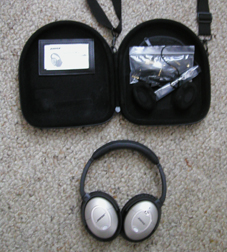
Its disadvantages: the Bose headset is much larger than the Sennheiser and does not fold. Its hard case takes up more room in your carry-on bag. (The Sennheiser case, with headset, is 7 1/2 by 4 ½ by 1 ü and weighs 6 ounces. The Bose case, with the headset, is 8 1/2 by 7 by 2 and weighs a pound.)
If you travel a lot and can afford it, I recommend the Bose. It cuts the noise so much that you almost feel as if you aren‘t in a plane. If you travel less frequently or have a smaller budget, get the Sennheiser. The sound of a seashell is still nicer than an engine‘s roar!
Sennheiser
877-736-6434
Bose QuietComfort 2
800-999-2673
Outside the U.S. 508-766-1099 or 1942

